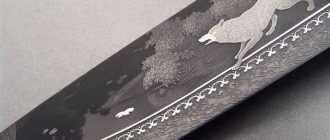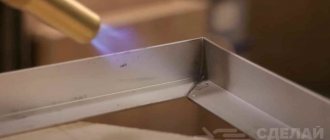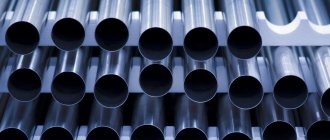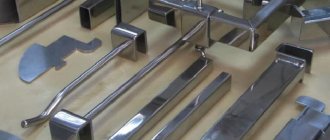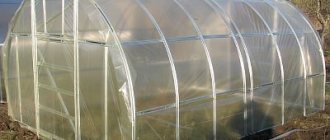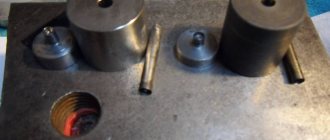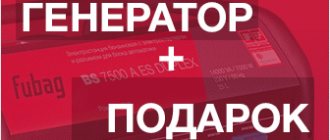Differences between metal soldering and welding
There are two main methods of joining two metals: welding and soldering. In the first case, the elements are held together by melting the edge of the metal. This can be either heating or bonding using pressure. In the case of soldering, the workpieces are fastened together using filler material - solder.
In some cases, soldering is a more gentle and economical way of joining workpieces. Soldering also has a number of advantages:
- Both parts do not heat up to the melting point. In this way, it is possible to preserve their physical and chemical properties.
- The workpieces do not require thorough cleaning and processing, as is required when welding.
- Soldering equipment costs much less than welding machines.
- Possibility of manufacturing complex units and structures.
- The strength of the resulting joint. The parts do not bend or deform after soldering.
Let's take a closer look at the methods of soldering different metals.
Where is it used?
Soldering technology takes an honorable second place in terms of frequency of use for joining materials . The championship belongs to welding. However, there are areas where, for certain reasons, it is impossible to use welding equipment and there is no worthy alternative to soldering. The statement is valid for the following industries:
- Production of electronic control boards. Soldering is used to attach miniature components.
- Refrigeration equipment. Copper tubes and heat exchangers are connected only by soldering. Repair of radiators for land transport and special equipment is carried out using this technology.
- Joining high-alloy alloys that are difficult to weld.
- Aviation industry. The intermediate layer of aircraft skin has a honeycomb structure. For its production, soldering is used in thermal furnaces.
The technology is used in cases where other types of connections, such as riveting, gluing or bolting, cannot be used for some reason. An important condition is the absence of requirements for high contact strength.
Soldering of non-ferrous metals
Products made of non-ferrous metals require precise fitting. That is why they are often soldered rather than boiled. Let's study certain types of non-ferrous metals and their bonding using soldering.
Important:
Always secure both workpieces using a vice, clamps or other fasteners. Especially if you are working with large parts. Vibrations or shifts during soldering can warp the seam and the solder can drip. This will make the joint brittle and, over time, cracks or fistulas may form on it.
Soldering copper
Copper is a fairly common metal in everyday life. Water pipes, electrical cables, electronic components - they are all partially or completely made of copper.
There are mainly two methods for soldering copper:
- High temperature (working temperature about 600 ˚С);
- Low temperature (working temperature up to 450 ˚C).
In this article, we are considering soldering at home, so we will take low-temperature technology.
To solder copper you will need:
- Solder. It is mainly made from alloys of tin (95-97%) with copper, antimony, bismuth, silver, and selenium. Silver-containing solders have the best properties. Three-component types, which include tin, copper and silver, are also widely used. The use of tin-lead solders in production is limited due to the harmfulness of lead. At home, you should also protect your lungs from lead fumes. Use an active hood.
- Flux for soldering copper (activated, acidic, non-acidic, anti-corrosion).
- Gas-burner.
Information:
Large industries and factories often use solder paste. Most often it contains: flux, small particles of solder and special additives.
Let's look at the step-by-step technology for soldering two copper elements:
- Flux is applied to both parts. They cover the joint and the area where solder will be applied.
- Solder is placed at the joint. This can be tin wire or a special paste.
- The resulting compound is heated using a gas burner. Solder is distributed over the joint, as well as partially over the area near the solder.
- The resulting workpiece is left to cool. At this moment, you cannot twist or bend the resulting part. The joint must be completely cool before the solder can fully harden.
- Remaining flux is removed using an abrasive brush.
Important:
Do not point an open flame directly at the solder. It should melt and fill the seam due to heating of the edges of the parts.
Soldering aluminum
Aluminum is a rather capricious material. Many experts believe that it is simply impossible to fasten two aluminum blanks at home, since the place of fastening must be heated to a temperature of about 600 ° C, and this risks burning out the aluminum sheet itself.
But this statement is not entirely true. You can solder two aluminum elements if you use a special flux and solder. Let's take a closer look at all the components that will be needed to work with aluminum:
- Solder. The best solders for working with aluminum are those containing: silicon, aluminum, copper, silver and zinc. These include domestic solder “34A” or its foreign analogue “Aluminium-13”.
- Flux. It is better if it contains ammonium fluoroborate with the addition of triethonalamine. Some people use regular borax.
- Soldering iron with a power of at least 100 W.
Healthy:
Solders with a high zinc content have better anti-corrosion properties.
Step-by-step guide to soldering aluminum blanks:
- Clean both workpieces from dirt and dust.
- Remove the oxide film using sandpaper. This operation is performed in order to reduce the oxide layer that instantly forms on the surface of the aluminum.
- Flux is applied to the joint.
- Solder is applied evenly and gradually, without subjecting the surface of aluminum workpieces to constant heating.
- The resulting joint is cleaned using a wire brush or fine sandpaper.
Soldering sheet metal
Ordinary tin is fastened quite simply. Metal without impurities or coating most often produces an even seam and does not change under the influence of high temperatures. To solder sheet metal you will need:
- Solder. Solders based on tin and antimony are mainly used. These include POS-40 or POS-30. In some cases, POS-90 is used, which contains lead.
- Flux. Both hydrochloric acid and ordinary rosin will do. Fresh oxide film on tin can be removed very easily.
- Soldering iron with a power of at least 40 W.
Soldering technology:
- Clean the tin elements from dirt and dust.
- Apply rosin to the joint.
- Place solder on the joint and use a soldering iron to melt it.
- Clean the resulting area using fine sandpaper or a wire brush to ensure a smooth seam.
Soldering galvanized iron
Unlike ordinary tin, galvanized iron has a number of specific characteristics. Firstly, zinc on the surface of the sheet evaporates at a temperature of 960˚C. Therefore, it is not recommended to use powerful burners when working with galvanized sheets.
Secondly, not all solders are suitable for working with galvanized iron. For example, it is highly not recommended to use POS-90 solder, as it destroys the structure of the sheet.
Soldering components:
- Solder. It is best to choose POS-30.
- Flux - boric acid or zinc chloride.
- Soldering iron with a power of at least 40 W.
The technology for soldering two galvanized elements is similar to working with ordinary sheet metal. The main thing is to heat the joint evenly, avoiding overheating of individual areas.
Soldering stainless steel
Stainless steel is an alloy containing nickel and chromium, as well as titanium. Soldering stainless steel is slightly different from similar work with regular or galvanized iron. Depending on the quantitative content of a particular metal in the composition of stainless steel, it will have different physical characteristics.
Thus, a sheet with a high nickel content at a temperature of 500 - 700 ˚C can release carbide compounds. Such sheets are subjected to uniform and rapid heating to avoid destruction of the material structure.
Let's look at the necessary components :
- Solder. It is selected depending on the soldering conditions. In open areas or high humidity, preference is given to solders based on silver alloys with a low nickel content. In dry rooms or blast furnaces, chromium-nickel or silver-manganese solders are used. For the initial tinning of two parts, ordinary solder based on tin and lead is used.
- Flux is borax in the form of powder or paste.
- Powerful gas burner producing temperatures above 800˚C. A soldering iron with a power above 100 W is useful for primary tinning.
Step-by-step soldering technology :
- Thoroughly clean the junction of two stainless steel elements.
- Secure both sheets and apply soldering acid flux to the joint.
- Tin the joint area with a thin layer of tin-based solder. At this stage, use a regular soldering iron. Be careful not to let the solder roll off the sheet. If this cannot be avoided, preheat the sheets and repeat tinning.
- Repeat tinning with flux.
- Solder both sheets using solder depending on the soldering conditions. Use a gas torch for this step.
Important:
If the solder rolls off the sheet even after preheating, use a wire brush. It helps remove the oxide film that may remain on the tinned surface after applying flux.
Varieties
Skeletal
Skeletal technology is a technology in which the base surface is examined under a layer of solder . It is characterized by economical consumption of metal for soldering and ease of visual inspection. It is used when working in the electrical field, in particular for connecting wires.
Wave
This type of soldering is used for attaching elements to printed circuit boards . The wave method was developed in the 50s of the twentieth century, with the active introduction of electronic circuits into various devices for household and industrial use. In mass production, fully automated lines operate.
One of the types of wave soldering is selective soldering. It is characterized by the selectivity of the effects of solder. It is used to process elements mounted in holes.
Cold
Cold soldering is a method in which a connection is formed due to the mutual penetration of elements into each other . The rate of reaction depends on the temperature and duration of contact. One of the simplest soldering circuits. Used for joining polyethylene and polypropylene products.
In domestic conditions, the cold method is used for installing linoleum and repairing polyethylene pipes.
It is indirectly related to the technology in question.
Lead-free
Modern technology, which began to actively develop after stricter environmental safety requirements. Currently, all Japanese electronics manufacturers have completely abandoned the use of lead solders. The lead-free method uses a combination of tin, silver, zinc and copper as the working alloy . The ratio and additional elements depend on the field of activity.
Contact
A type of soldering in which parts with different compositions are connected . The technological cycle includes a short-term change in the state of aggregation of the contact area. For reliable fastening, a layer is often used, which helps to achieve the desired result. Failure to comply with this rule will result in very low contact strength. Consumables are called eutectics. This way you can combine copper with aluminum, where there will be an aluminum-copper alloy between the parts. A distinctive feature is the high reaction speed.
High temperature
A distinctive feature of this soldering method is the high temperature impact on the workpiece . As a result, the connection will be resistant to temperature changes, as well as a high strength index. You have to pay for quality - this method is considered the most difficult from a technological point of view.
In some cases, the temperature should reach 1000 Cº. For this reason, it is impossible to use conventional soldering irons for high-temperature soldering - more powerful thermal energy generators are required.
Induction
A high-frequency current is used as a heat source, which affects the products being connected . The generator are special inductors that you can make yourself. There are stationary and mobile types of installations.
To avoid activation of oxidative processes, work is carried out in a vacuum environment. It is allowed to connect parts in atmospheric air, provided that special self-fluxing solders are used.
Infrared
Another modern method, which is based on the principle of heating workpieces with electromagnetic waves . Heating elements are made of quartz or ceramics.
An infrared soldering station is a complex device, the cost of which does not allow its use in domestic conditions. The main advantage is that electromagnetic waves of the invisible spectrum do not pose a threat to human health.
Capillary
The most common method of soldering products. The essence of the technology is that when the temperature increases, the solder applied to the surface melts and occupies the entire space between the parts being connected .
The method is used both at home and in production. The basis of any method is capillary technology, like the very idea of soldering - applying hot solder to the surface.
Soldering of ferrous metals
The quality of fastening of steel products depends on several factors:
- steel grades;
- porosity of workpieces;
- level of cleanliness of the joining seam.
Tin or brass alloys are chosen as solder. They are used depending on the task at hand. An easier way is to use tin. It is easier to work with, however, the final seam will not have a high level of strength.
Brass-based solders are much stronger, but you will need special equipment to work with them.
The work process at the preparatory stage is practically the same. In both cases, the parts are cleaned of dirt and rust. Fix with clamps or a vice. Orthophosphoric acid is used as a flux. After this comes the soldering stage.
Soldering steel with tin
When soldering with tin, select a soldering iron with a power of 100 W or more. To obtain a high-quality seam, both parts are pre-tinned, after which tin solder is fed into the finished seam and soldering is completed.
Soldering steel with brass
Brass melts at temperatures above 900 °C, so to work with such solder you will need a gas torch. It is important to heat both elements evenly. Otherwise, the brass will quickly melt. It will only adhere well to the edges of steel workpieces (which can cause brittleness and stress failure), which will contribute to the formation of cracks in the final product.
Contact reaction
A type of soldering called “contact-reaction” or “reactive” means the process of fusion when two parts made of different metals come into contact.
A phase transition of the metal from solid to liquid occurs, followed by hardening and fusion. Often such a connection is made through a thin layer, which is applied to one of the workpieces by galvanic or other means.
Low-melting materials – eutectics – are used. This way you can combine silver and copper, where a copper-silver alloy will be formed between the parts. They carry out soldering of tin and bismuth, silver and beryllium, graphite and steel.
You can solder aluminum to other materials through a layer of copper or silicon. The connection is strong, soldering time takes a fraction of a second.
Tips for proper and strong soldering of metals
When working with steel or other metals, you must adhere to basic safety rules and also know some of the nuances of soldering.
How to heat and cool metal
An important step before starting work is preparing the workpieces. And here you need to know for sure which alloy you will solder or check it yourself:
- See how a metal workpiece reacts to heating with a soldering iron or torch. How quickly an oxide film forms on the surface. It’s better to know this in advance and for sure, otherwise subsequent work will be done in a hurry.
- It is best to warm up the prepared and secured parts gradually. Make sure that no overheated spots appear on the metal. The soldering area must be heated evenly over the entire area.
- Do not heat only the butt seam; also work on the area near the joint. Most often, you need to warm up 0.5 - 2 cm, depending on the purpose of soldering and the dimensions of the elements being connected.
- Use only soldering irons or torches that produce solder at operating melting temperature.
- Do not cool the finished seam with cold water or other liquids. Let the metal “rest” and cool evenly for several minutes in the open air.
- Remove soldered workpieces from a vice or clamps only after the solder has completely cooled.
Fluxes
Its purpose is to protect the contact surface from oxide film. A high-quality flux should remove traces of rust before work, and also prevent the appearance of fresh traces of corrosion. They differ in the following parameters:
- Chemical activity.
- Heating temperature.
- Water content of the composition (aqueous/anhydrous).
- Release form (paste, gel, liquid).
The most popular fluxes are:
- Boric acid;
- Borax (sodium salt of boric acid);
- Rosin;
- Orthophosphoric acid;
- Zinc chloride.
If necessary, you can make your own soldering acid.
Which metals are most strongly soldered to each other?
Unlike welding, in soldering the main indicator of the quality of the finished product is not the grade of steel or metal, but the choice of solder, as well as the technology for forming the solder seam itself. So the question here is rather about which metal, which solder sticks best to which metal. Of course, the closer in composition and density the solder and metal are, the better the adhesion will be. In the end, it all comes down to choosing the right solder for each individual case.
You also need to ensure that when connecting two metals, no electric couples are formed. Otherwise, the connection will rust and collapse from the slightest moisture. So a compatibility table for connecting non-ferrous metals with each other would be appropriate here.
The letter “A” in the compatibility table means “limitedly permissible in atmospheric conditions.”
Here are some more simple tips :
- Choose solders that are more refractory.
- Carefully clean the joints of fastened parts. Apply sandpaper not only to the seam itself, but also 0.5 - 2 cm near the joint on the metal surface.
- Tin and overlap seal. Thus, you increase the total area of fastening two or more parts.
Safety precautions when soldering steel at home
Often, neglect of basic rules for working with electrical or flammable appliances leads to loss of health or damage to property.
I strongly recommend following safety precautions when soldering:
- Keep the soldering iron on a metal pad or a special holder that takes the heated tip of the tool away from the plane of the table.
- Turn off the soldering iron from the mains immediately after finishing work.
- Check the quality of the connection of the gas cylinder to the burner itself. Avoid gas leaks.
- Work in a well-ventilated area.
- Do not leave the burner on if you have already finished working.
- Remove any flammable substances from the work area.
- Do not touch the heated seam with your bare hands. You may get burned.
- Do not touch the solder with your fingers to check the strength of the seam.
By following these measures, you can avoid injuries and also keep your property intact. Solder with pleasure and knowledge!
Reaction-flux
The reactive flux type of soldering is based on a chemical reaction in which solder is formed from flux when combined with metal. This is clearly visible when aluminum parts are connected to each other.
To join them, a flux based on zinc chloride is used. When heated, zinc begins to interact with aluminum, turning into metal solder.
It fills the entire gap space, making the soldering area a strong connection. In this case, it is very important to accurately observe the proportions of the applied flux. There must be a lot of it so that pure zinc in the required quantity can be released from the flux powder.
Sometimes with this type of soldering it is necessary to add zinc solder in small quantities as an addition to the main process. This is usually done if two pieces are overlapped.
Selective
It cannot be said that the selective type of soldering is fundamentally different from capillary soldering. Solder and heat are used in the same way. But the solder is melted only in selected places (local points) to which the elements are planned to be attached.
Selective soldering is used mainly for the manufacture of circuit boards and pin components. It is similar to the wave method used for soldering SMD chips.
Selective soldering installation is equipment belonging to the semi-automatic category. It is not cheap, but it saves consumables almost ten times compared to the wave, so it is distributed wider and wider.
Solder classification
Modern solders can be roughly divided into two groups:
- Melting at low temperatures.
- Melting under high temperatures.
As already noted, low-temperature soldering is performed at 450°C and below. The solder itself for this type of operation must soften already at 300°C. Such materials include a wide group of tin alloys with the addition of zinc, lead and cadmium.
High-temperature melt media are used for soldering at temperatures of around 500°C. These are mainly copper compounds, which also include nickel, phosphorus and zinc. It is important to note that, for example, tin-lead-cadmium solder, in addition to its lower melting point, will differ from copper alloys in mechanical strength. The ratio of resistance to physical pressure can be represented as follows: 20 – 100 MPa versus 100 – 500 MPa.
